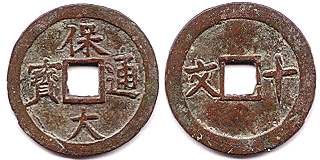
Vietnamese cash
Encyclopedia

Cash (Chinese coin)
A cash was a type of coin of China and East Asia from the 2nd century BC until the AD 20th century. The photograph to the right shows replicas of various ancient to 19th century cast coins in various metals found in China and Japan.-Terminology:...
, Japan and Korea
Korean mun
The mun was introduced as the main currency of Korea in 1633 and stayed in use until 1892. It resembled and was derived from the Chinese wen . Coins denominated in mun were cast in copper or bronze and were round with square holes. In 1888, coins were struck in small numbers denominated in mun and...
for centuries.
History
The first Vietnamese coins were cast under the rule of the Đinh Dynasty (968-981).Cash coins circulated in the 19th century along with silver and gold bars, as well as silver and gold coins known as tiền. Denominations up to 10 tien were minted, with the 7 tiền coins in gold and silver being similar in size and weight to the Spanish 8 real and 8 escudo pieces. These coins continued to be minted into the 20th century, albeit increasingly supplanted by French colonial coinage.
After the introduction of modern coinage
Cochinchina Piastre
In 1885, the French Indochina administration, governing the Protectorates of Annam, Cambodia, Tonkin, and the Colony of Cochinchina was created by the decree of 22 December....
by French in 1878,
cash coins remained in circulation until 1945 and were valued at the rates of about 500-600 cash for one piastre
French Indochinese piastre
The piastre de commerce was the currency of French Indochina between 1885 and 1952. It was subdivided into 100 cent, each of 5 sapeque.-History:...
.
The last king
Bảo Đài
Bảo Đài is a commune and village in Lục Nam District, Bac Giang Province, in northeastern Vietnam.-References:...
whose name was cast on cash coins died in 1997.
Machine-struck cash
There were several efforts by French administration to produce machine-struck cash (sapeque):Emperors Khải Định (1916–1925) and Bảo Đại
Bảo Đài
Bảo Đài is a commune and village in Lục Nam District, Bac Giang Province, in northeastern Vietnam.-References:...
(1925–1945)
produced both cast and machine-struck cash.
See also
Vietnamese dynasties- CashCash (Chinese coin)A cash was a type of coin of China and East Asia from the 2nd century BC until the AD 20th century. The photograph to the right shows replicas of various ancient to 19th century cast coins in various metals found in China and Japan.-Terminology:...
- Chinese cash
- Japanese mon
- Korean munKorean munThe mun was introduced as the main currency of Korea in 1633 and stayed in use until 1892. It resembled and was derived from the Chinese wen . Coins denominated in mun were cast in copper or bronze and were round with square holes. In 1888, coins were struck in small numbers denominated in mun and...

